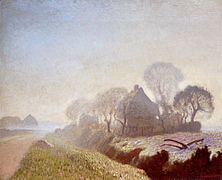George Clausen
Sir George Clausen RA RWS RI ROI (18 April 1852 – 22 November 1944) was a British artist working in oil and watercolour, etching, mezzotint, drypoint and occasionally lithographs. He was knighted in 1927.[1][2]
Biography
[edit]George Clausen was born at 8 William Street[3] in the Regents Park district of London on 18 April 1852, the son of a decorative artist of Danish descent and a Scottish mother. From 1867 to 1873, he attended design classes at the South Kensington Schools in London with great success. He then worked in the studio of Edwin Long RA and subsequently in Paris under Bouguereau and Tony Robert-Fleury at the Académie Julian.[4][5] He was an admirer of the naturalism of the painter Jules Bastien-Lepage about whom he wrote in 1888 and 1892.
Clausen became one of the foremost modern painters of landscape and of peasant life, influenced to a certain extent by the Impressionists, with whom he shared the view that light is the real subject of landscape art.[6] His pictures excel in rendering the appearance of things under flecking outdoor sunlight, or in the shady shelter of a barn or stable. His Girl at the Gate was acquired by the Chantrey Trustees and is now at the Tate Gallery.[5][7] The Yale Center for British Art holds Clausen's Schoolgirls (1880),[8] an urban scene, which it featured in its exhibit called "Britain in the World: 1860-Now."[9]
Other landscapes included "The Fields in June" (1914) and "Midsummer Dawn" (1921). For the Imperial War Museum he painted the large, broadly decorative, "Gun Factory at Woolwich Arsenal" (1919). His decorative work also included "Renaissance" (1915) and decorations for the Hall at High Royd, Huddersfield, consisting of life-size figures in lunettes.[10]
Clausen was a founding member of the New English Art Club in 1886. In 1895, he was elected an Associate of the Royal Academy, and a full Academician in 1906.[11] He was elected as the Master of the Art Workers' Guild in 1909.[12] As Professor of Painting at the Royal Academy he gave a memorable series of lectures to the students of the Schools, published as Six Lectures on Painting (1904) and Aims and Ideals in Art (1906).[5][4]
Clausen was an official war artist during World War I. During the war his daughter's fiancé was killed; this event may have inspired his painting, Youth Mourning which shows a distressed young woman mourning in a desolate landscape.[13][14] Clausen also contributed six lithographs on the theme Making Guns for the Government published print portfolio Britain's Efforts and Ideals.[15]
In 1921 Clausen was an original Society of Graphic Art member and showed his work in their first exhibition.
He died at home in the village of Cold Ash in 1944 and was buried there next to his wife in the parish churchyard.[16]
- Selected works
-
Bird scaring, 1887
-
Girl, 1888
-
Ploughing, 1889
-
Brown eyes, 1891
-
Apple blossom
-
The Gleaners Returning, 1908
-
Youth Mourning, 1916
-
Morning in November, 1922
References
[edit]- ^ "Artist biography, George Clausen R.A". Tate. Retrieved 4 October 2016.
- ^ "Sir George Clausen RA RSW RWS HRBA RI ROI NEAC (1852-1944)". Chris Beetles Gallery. Archived from the original on 15 February 2023.
- ^ "Chris Beetles Gallery".
- ^ a b Ian Chilvers (2004). The Oxford Dictionary of Art. Oxford University Press. ISBN 0-19-860476-9.
- ^ a b c Chisholm 1911.
- ^ Brian Stewart & Mervyn Cutten (1997). The Dictionary of Portrait Painters in Britain up to 1920. Antique Collectors' Club. ISBN 1-85149-173-2.
- ^ "Catelogue entry, The Girl at the Gate". Tate. Retrieved 4 October 2016.
- ^ Clausen, George (1880). "Schoolgirls". Yale Center for British Art. Retrieved 22 November 2021.
- ^ Yale Center for British Art (2019). Britain in the world : highlights from the Yale Center for British Art : in honor of Amy Meyers. Amy R. W. Meyers, Martina Droth, Nathan Flis, Michael Hatt. New Haven, CT. ISBN 978-0-300-24747-3. OCLC 1088665967.
{{cite book}}: CS1 maint: location missing publisher (link) - ^ Chisholm, Hugh, ed. (1922). . Encyclopædia Britannica. Vol. 30 (12th ed.). London & New York: The Encyclopædia Britannica Company. p. 701.
- ^ Frances Spalding (1990). 20th Century Painters and Sculptors. Antique Collectors' Club. ISBN 1-85149-106-6.
- ^ Kenneth McConkey (1980). Sir George Clausen, R.A. 1852-1944. City of Bradford Metropolitan District Council and Tyne and Wear County Council. p. 78. ISBN 9780905974040.
- ^ Art from the First World War. Imperial War Museum. 2008. ISBN 978-1-904897-98-9.
- ^ Imperial War Museum. "First World War archive, George Clausen". Imperial War Museum. Retrieved 14 September 2016.
- ^ Mari Gordon, ed. (2014). The Great War:Britain's Efforts and Ideals. Amgueddfa Cymru-National Museum Wales. ISBN 9780720006278.
- ^ "Sir George Clausen RA".
Attribution:
- This article incorporates text from a publication now in the public domain: Chisholm, Hugh, ed. (1911). "Clausen, George". Encyclopædia Britannica. Vol. 6 (11th ed.). Cambridge University Press. p. 467.
Sources
[edit]- Gibson, Frank. The Etchings and Lithographs of George Clausen, R.A. The Print Collector's Quarterly 1921 July Vol 8, No. 2, pp 203, 212.
- Gibson, Frank. Notes to Catalogue of Etchings by George Clausen The Print Collector's Quarterly 1921 Dec Vol 8, No. 4, p 433.
- Rutherson, Albert (editor). Contemporary British Artists: George Clausen Publisher: Ernest Benn Ltd, 1923
- Sir George Clausen, R.A. 1852–1944; Bradford Art Gallery, 1980. Catalogue of an exhibition held in Bradford, London, Bristol and Newcastle upon Tyne in 1980.
External links
[edit]- 153 artworks by or after George Clausen at the Art UK site
- Works by Clausen in the Imperial War Museum collection
- 1852 births
- 1944 deaths
- 19th-century English painters
- English male painters
- 20th-century English painters
- British landscape painters
- British war artists
- Painters from London
- Royal Academicians
- Académie Julian alumni
- World War I artists
- Masters of the Art Worker's Guild
- 20th-century English male artists
- 19th-century English male artists









